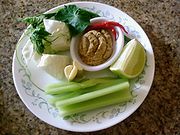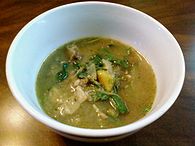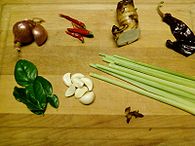
Kroeung
Encyclopedia
Kroeung is the base flavor of many Khmer dishes, often being dubbed with the "Kroeung" suffix. similar in form and function to Thai
curry paste
s. There are many ingredients that can be pounded into the herb paste, but the eight most commonly used are Lemon grass, Kaffir lime zest and leaves
, Galangal
, Turmeric
, Rhizome
, Garlic
, Shallots, and Dried Red Chillies
.
This herbal paste is essential in order to create the authentic flavour for preparing Khmer dishes.
 Kroeung has two main categories: Individual Kroeung and Royal Kroeung. Individual Kroeung are unique dishes which may call for extra ingredients to be blended in. Royal Kroeung on the other hand includes additional herbs, such as kaffir lime leaves. Kroeung can be further distinguished by the dishes' colors, which are yellow, green and red. The Color Kroeung are commonly used to make stuffings, soup, and stir-fry.
Kroeung has two main categories: Individual Kroeung and Royal Kroeung. Individual Kroeung are unique dishes which may call for extra ingredients to be blended in. Royal Kroeung on the other hand includes additional herbs, such as kaffir lime leaves. Kroeung can be further distinguished by the dishes' colors, which are yellow, green and red. The Color Kroeung are commonly used to make stuffings, soup, and stir-fry.
(អាម៉ុកត្រី) is considered an Individual Kroeung since it uses the red kroeung base but omits Turmeric
in place of Kaffir lime
leaves. It is also worth noting that many Kroeung recipes, specifically for curries, requires whole spices to be ground with the herb paste. Curry powder can also be used in place of the whole spices. These types of Kroeung are also considered to be Individual Kroeung because many of these curries are exclusively used in the respective curry for which it is specifically made.

Cambodians living abroad use Kaffir lime leaves instead of Kaffir lime zest, which is actually the whole lime rind that has been sun-dried, as Kaffir limes are not widely available outside of Cambodia, and by extension the South East Asian region.
The list of ingredients in these Color Kroeung will vary from recipe to recipes, and there are some ingredients included purely for their coloring ability.
 Lemongrass stalks are used in this paste, rather than lemongrass leaves, as the leaves impart a green to the dish when cooked which can overpower the red chilli coloring. The lemongrass stalk is a pale beige color, so it easily takes on the dominant red hues from the red peppers.
Lemongrass stalks are used in this paste, rather than lemongrass leaves, as the leaves impart a green to the dish when cooked which can overpower the red chilli coloring. The lemongrass stalk is a pale beige color, so it easily takes on the dominant red hues from the red peppers.
 1. In a stone mortar, finely pound the kaffir lime leaves or zest till a smooth consistency is reached. Add the soaked chilli pod and red peppers till the paste becomes bright red in color.
1. In a stone mortar, finely pound the kaffir lime leaves or zest till a smooth consistency is reached. Add the soaked chilli pod and red peppers till the paste becomes bright red in color.
2. Add the chopped lemongrass stalks and cubed galangal and pound with the pestle until all ingredients are incorporated. If using fresh turmeric, add it to stone mortar as well. The texture should feel fibery but moist.
3.Next add the garlic and shallots till the entire mixture is blood-red in color and the texture feels somewhat pliable.
4. Lastly fold the turmeric into the kroeung if using the powdered form.
Cuisine of Thailand
Thai cuisine is the national cuisine of Thailand. Blending elements of several Southeast Asian traditions, Thai cooking places emphasis on lightly prepared dishes with strong aromatic components. The spiciness of Thai cuisine is well known. As with other Asian cuisines, balance, detail and variety...
curry paste
Curry paste
Curry paste is a moist blend of ground or pounded herbs and/or spices and other seasonings. Curry paste is an important ingredient in Thai cuisine, and can also be a generic commercial product that replaces curry powders or spice blends in other cuisines....
s. There are many ingredients that can be pounded into the herb paste, but the eight most commonly used are Lemon grass, Kaffir lime zest and leaves
Kaffir lime
The kaffir lime, Citrus × hystrix, Rutaceae), is also known as combava, kieffer lime, limau purut, jeruk purut or makrut lime,...
, Galangal
Galangal
Galangal is a rhizome of plants of the genus Alpinia or Kaempferia in the ginger family Zingiberaceae, with culinary and medicinal uses originated from Indonesia...
, Turmeric
Turmeric
Turmeric is a rhizomatous herbaceous perennial plant of the ginger family, Zingiberaceae. It is native to tropical South Asia and needs temperatures between 20 °C and 30 °C and a considerable amount of annual rainfall to thrive...
, Rhizome
Rhizome
In botany and dendrology, a rhizome is a characteristically horizontal stem of a plant that is usually found underground, often sending out roots and shoots from its nodes...
, Garlic
Garlic
Allium sativum, commonly known as garlic, is a species in the onion genus, Allium. Its close relatives include the onion, shallot, leek, chive, and rakkyo. Dating back over 6,000 years, garlic is native to central Asia, and has long been a staple in the Mediterranean region, as well as a frequent...
, Shallots, and Dried Red Chillies
Thai pepper
Bird's eye chili or "Thai chili" is a chili pepper of the species Capsicum frutescens L. in the family Solanaceae, commonly found in South-east Asia. It can also be found in India, mainly Kerala, where it is used in traditional dishes of the Kerala cuisine...
.
This herbal paste is essential in order to create the authentic flavour for preparing Khmer dishes.

Individual Kroueng
Kroeung that are pounded for specific single dishes or have only one unique use falls into this category. Individual Kroeung also consists of extra ingredients not found in its base recipe. Somlar Kako(សម្លកកូរ), for example, requires roasted ground rice for the smoky flavor of the soup. The Kroeung in AmokAmok trey
Amok trei , or steamed curried fish, is a traditional dish of Cambodian cuisine. It is fish coated in a thick coconut milk with kroeung, either steamed or baked in a cup made from banana leaves. It is often eaten during the Water Festival, which celebrates the reversal of the Tonle Sap River....
(អាម៉ុកត្រី) is considered an Individual Kroeung since it uses the red kroeung base but omits Turmeric
Turmeric
Turmeric is a rhizomatous herbaceous perennial plant of the ginger family, Zingiberaceae. It is native to tropical South Asia and needs temperatures between 20 °C and 30 °C and a considerable amount of annual rainfall to thrive...
in place of Kaffir lime
Kaffir lime
The kaffir lime, Citrus × hystrix, Rutaceae), is also known as combava, kieffer lime, limau purut, jeruk purut or makrut lime,...
leaves. It is also worth noting that many Kroeung recipes, specifically for curries, requires whole spices to be ground with the herb paste. Curry powder can also be used in place of the whole spices. These types of Kroeung are also considered to be Individual Kroeung because many of these curries are exclusively used in the respective curry for which it is specifically made.

Royal Kroeung
Royal Kroeung is used for royal dishes. The difference between Royal and Individual Kroeung is the extra ingredient used to make the paste, Chinese Parsley and Kaffir Lime leaves. This does not conclude that all Royal Kroeung requires the two extra ingredients, but it is only an additional or substituted herb to the original recipe.Cambodians living abroad use Kaffir lime leaves instead of Kaffir lime zest, which is actually the whole lime rind that has been sun-dried, as Kaffir limes are not widely available outside of Cambodia, and by extension the South East Asian region.
Color Kroeung
There are three distinct color groups into which all Kroeung can be categorized: Red, Green, and Yellow. The dominant herb or spice present in the spice-blend paste tints the three different color Kroeung. Uncooked Kroeung will often change color as it cooks.The list of ingredients in these Color Kroeung will vary from recipe to recipes, and there are some ingredients included purely for their coloring ability.
Red Kroeung
គ្រឿងក្រហម Kroeung Kraharm or Red Kroeung in Khmer, receives its deep color from a type of chilli pods which contributes very little flavor to the Kroeung. This desirable trait of adding a natural red color from the pulp of the chilli makes it more useful than red peppers, although as the dish is meant to be spicy, hotter chilli peppers may also be used in the spice paste.
- Lemongrass stalk
- Turmeric
- Shallot
- Garlic
- Galangal
- Dried red pepper
Preparation Method
There are many ingredients that require advanced preparation prior to pounding the herbs and spices to make this specific Kroeung.- Soak, deseed, and drain the excess water from the chilli pod and dried red pepper.
- Thinly slice the lemongrass stalks and dice the fresh galangal. If using fresh or brine-soaked turmeric, dice this as well.
- If using Kaffir lime zest, slice into thin strips. If using the Kaffir lime leaves, devein and chop thinly. Slice the garlic and shallot thinly.

2. Add the chopped lemongrass stalks and cubed galangal and pound with the pestle until all ingredients are incorporated. If using fresh turmeric, add it to stone mortar as well. The texture should feel fibery but moist.
3.Next add the garlic and shallots till the entire mixture is blood-red in color and the texture feels somewhat pliable.
4. Lastly fold the turmeric into the kroeung if using the powdered form.
Green Kroeung
- Lemongrass, leaf : stalk, 3:1
- RhizomeKaempferia galangaKaempferia galanga, commonly known as kencur, aromatic ginger, sand ginger, cutcherry or resurrection lily, is a monocotyledonous plant in the ginger family. It is found primarily in open areas in Indonesia, southern China, Taiwan, Cambodia and India, but is also widely cultivated throughout...
- CinnamonCinnamonCinnamon is a spice obtained from the inner bark of several trees from the genus Cinnamomum that is used in both sweet and savoury foods...
- GalangalGalangalGalangal is a rhizome of plants of the genus Alpinia or Kaempferia in the ginger family Zingiberaceae, with culinary and medicinal uses originated from Indonesia...
- TurmericTurmericTurmeric is a rhizomatous herbaceous perennial plant of the ginger family, Zingiberaceae. It is native to tropical South Asia and needs temperatures between 20 °C and 30 °C and a considerable amount of annual rainfall to thrive...
- PrahokPrahokPrahok is a crushed, salted and fermented fish paste that is used in Cambodian cuisine as a seasoning or a condiment. It originated as a way of preserving fish during the longer months when fresh fish was not available in abundant supply...
(optional)

